| Revision as of 03:48, 12 July 2011 editBars77 (talk | contribs)190 edits →Sev Ghul← Previous edit | Revision as of 03:52, 12 July 2011 edit undoBars77 (talk | contribs)190 edits →ReligionNext edit → | ||
| Line 112: | Line 112: | ||
| <center> | <center> | ||
| <gallery widths="140px" heights="140px" perrow=5> | <gallery widths="140px" heights="140px" perrow=5> | ||
| File:The Holy Saviour Church of Gyumri.jpg|Surb Astvatsastin (Yot Verk |
File:The Holy Saviour Church of Gyumri.jpg|Surb Astvatsastin Church (Holy Mother of God, also known as'' Yot Verk'' - Seven Wounds) | ||
| File:Holy |
File:Holy Savior church under renovation Gyumri.jpg|The Cathedral of the Holy Savior (built in 1847) being reconstructed after the earthquake of 1988 | ||
| File:Gyumri, la Iglesia rusa.JPG|The Russian church of Saint Nikolai the |
File:Gyumri, la Iglesia rusa.JPG|The Russian church of Saint Nikolai the Wonderworker | ||
| File:Gyumri. La Iglesia negra descrita por Gurdjieff.JPG|Surb Nshan Church | File:Gyumri. La Iglesia negra descrita por Gurdjieff.JPG|Surb Nshan (Holy Sign) Church | ||
| File:St-Hagop gyumri.jpg|Surb Hakob Church | File:St-Hagop gyumri.jpg|Surb Hakob (St. Jacob) Church | ||
| </gallery> | </gallery> | ||
| </center> | </center> | ||
Revision as of 03:52, 12 July 2011
Place in Shirak, Armenia| Gyumri Գյումրի | |
|---|---|
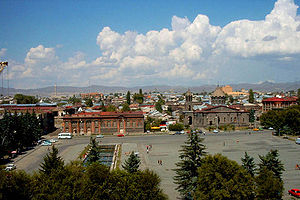 Gyumri from Vardanants Square Gyumri from Vardanants Square | |
 Seal Seal | |
| Country | |
| Marz | Shirak |
| Established | 401 BC |
| Government | |
| • Mayor | Vartan Ghukasyan |
| Area | |
| • City | 45 km (17 sq mi) |
| Elevation | 1,509.3696 m (4,952.0000 ft) |
| Population | |
| • Density | 3,253/km (8,430/sq mi) |
| • Metro | 146,400 |
| Time zone | UTC+4 (GMT+4) |
| • Summer (DST) | UTC+5 (GMT+5) |
| Website | www.gyumri.am |
| Sources: Population | |
40°47′22″N 43°50′51″E / 40.78944°N 43.84750°E / 40.78944; 43.84750 Gyumri (Template:Lang-hy, "Gyoumri") is the capital and largest city of the Shirak Province in northwest Armenia. It is located about 120 km from the capital Yerevan, and, with a population of 168,918 (2008; up from 150,917 reported at the 2001 census), is the second-largest city in Armenia.
The name of the city has been changed many times in history. It was first known as Kumayri or Gyumri, then Alexandrapol (1840–1924), then Leninakan (Template:Lang-hy, 1924–1990), then again as Gyumri.
The city is situated on a 126 km distance north to Yerevan in the central part of the Shirak Highland, at an approximate height of 1550 meters above sea level. The Akhurian River passes through the western suburbs of Gyumri. Gyumri's climate is characterised with very severe and cold winters, where the minimum temperature could fall down to −41 °C (−42 °F). On the other hand, summers in Gyumri are relatively hot with temperatures could reach up to 36 °C (97 °F). The annual precipitation makes up to 500 millimetres (20 in) in average.
History

Gyumri is one of the oldest localities in Armenia. The region of Gyumri is mentioned in different Urartian inscriptions since the 8th century BC. The first settlement at the location occupied by today's city of Gyumri is believed to have been founded some time in the 5th century BC, perhaps ca. 401 BC, by Greek colonists. An alternative theory suggests that the city was founded by Cimmerians, based on the fact that Cimmerians conquered the region in 720 BC and that the original name of the city was Kumayri, which bears phonetic resemblance to the word used by ancient Armenian in reference to Cimmerians. Historians believe that Xenophon passed through Gyumri during his return to the Black Sea, a journey immortalized in his Anabasis.
During the Middle Ages Gyumri was known as a large and important settlement, and a center of Armenian rebellion against the Caliphate (733-755)
19th century
Gyumri continued to develop in the 19th century, when, along with its surroundings, it became part of Russia after the Russo-Persian War (1804-1813). Gyumri came under Russian control in 1804 around 25 years earlier than the rest of Eastern Armenia. During this period it was one of the best-known cities of the Transcaucasus region. In 1829, in the aftermath of the Russo-Turkish War there was a big influx population as about 3000 families, who had migrated from territories within the Ottoman Empire, in particular from the towns of Kars, Erzurum, and Doğubeyazıt, settled in and around Gyumri. The Russian poet Alexander Pushkin visited Gyumri during his journey to Erzurum in 1829.
In 1837 Russian Czar Nicholas I arrived in Gyumri and renamed the town Alexandropol. The name was chosen in honor of Czar Nicholas I's wife, Princess Charlotte of Prussia, who had changed her name to Alexandra Fyodorovna after converting to Orthodox Christianity. During the Soviet era Gyumri was renamed Leninakan in Lenin's honor. A major Russian fortress was built on the site in 1837. In the 1840s, Alexandropol (a town since 1840) experienced rapid growth. It was an important outpost for the Imperial Russian military in the Transcaucasus where their military barracks were established (e.g. at Poligons, Severski, Kazachi Post).
20th century and beyond

Ottoman forces captured Gyumri on May 11 1918 during the Caucasus Campaign in World War I but withdrew from it on December 24, 1918 after being required to under the Armistice of Mudros. During the Turkish-Armenian War, Turkey attacked Gyumri and occupied the city on November 7, 1920, after winning the Battle of Alexandropol. After the battle, the Turkish forces were headquartered in Gyumri. From this city the Turks presented the Armenian republic with an ultimatum that Armenia was forced to accept—otherwise Turkey would have invaded Yerevan, Armenia's capital, from their headquarters in Gyumri. Armenia was forced to sign the Treaty of Alexandropol to stop the Turkish advance towards Yerevan, the capital of the Democratic Republic of Armenia, thus ending the Turkish-Armenian War. Turkish forces withdrew from Alexandropol afterwards Treaty of Batum.
In 1924 the name was changed to Leninakan after the deceased Soviet leader Vladimir Lenin. Leninakan was a major industrial center for the Armenian Soviet Socialist Republic and its second largest city, after Yerevan, the capital. The city suffered major damage during the 1988 Spitak earthquake, which devastated large parts of the country.
The current name of the city was decided in 1990, at the time of the breakup of the Soviet Union. The Russian 102nd Military Base is located in the city. Today, Gyumri is Armenia's second largest city.
Main sites



As an old town, Gyumri has rich history and a unique style of architecture. Unfortunately it lost many of its historical and cultural buildings after the disastrous earthquake in December of 1988.
During the centuries Gyumri, the "city of trades and arts", has been famous for its schools, theaters, and gusans . The first opera performance in Armenia took place in Gyumri in 1912, and the first Armenian opera theater was also opened here, in 1923.
Kumayri
The Kumayri historic district in the city of Gyumri is said to resemble an open air museum. It is the old part of Gyumri with more than one thousand 18th and 19th century buildings. It is also one of the few places in the Republic of Armenia with an authentic historical Armenian urban architecture. Nearly all the buildings in the Kumayri district have survived two major earthquakes, in 1926 and 1988. The district is in the center of Gyumri.
Archeological excavations conducted in the 20th century have shown that the area has been populated since at least the third millennium BC. Many graveyards and dwellings have been found. The first recorded mention of Kumayri is from 773 and describes the revolt against Arab domination led by prince Artavazd Mamikonian that resulted in the revival of Armenian statehood one century later. Later, during and after the reign of the Bagratid kings of Armenia, Kumayri developed into a well-built modern town that was a center of commerce for the region.
Sev Ghul
Sev Ghul (meaning "Black Sentry") is a Russian fortress in Gyumri dating to the 1830s. It is built on a hill, heavily armed and, in case of a siege, the fortress site could accommodate 15,000 soldiers and officers. The monumental statue of "Mother Armenia of Gyumri" stands on an adjacent hill. The 102nd military division of the Russian Federation is stationed near another old Russian fortress known as Red Fort.
Other sites
- The Aslamazyan Sisters House-Museum built in the 1880s, housing nearly 700 drawings, paintings and other works of The, the Soviet-era artists "Aslamazyan sisters".
- The Dzitoghtsyan House-Museum or the Museum of National Architecture and Urban Life of Gyumri, an old Gyumri mansion, houses collections covering both the history and everyday life of Gyumri as well as paintings and other works of art.
- The Merkurov House-Museum.
- House-Museum of Avetik Isahakyan.
- House-Museum of Hovhannes Shiraz.
- House-Museum of Mher Mkrtchyan.
- Cathedral of the Holy Mother of God or the Seven Wounds of the Holy Mother of God, built in the 17th century.
- Church of the Holy Saviour or Surb Amenaprkich, constructed between 1859-1873. Designed to resemble the Cathedral of Ani. The church was heavily damaged by the 1988 Spitak earthquake and is currently under reconstruction.
- Surb Neshan Apostolic Church, built in 1870.
- The Russian Orthodox church of Saint Nikolai the Wondeworker, also known as "Plplan Zham" (the Shimmering Chapel), built in 1879-80.
- Saint Gregory the Illuminator's Church of Gyumri.
- Saint Jacob of Nisibis Apostolic Church (Surb Hakob Mtsbinetsi) built in 2005.
- Gyumri's Central Park, founded during the 1920s on the site of the old town cemetery.
The restoration project of the damaged buildings of Gyumri has been spearheaded by Earthwatch to preserve the city's unique architecture.
Religion
Almost the entire population of Gyumri belongs to the Armenian Apostolic Church. Gyumri is the home of the Diocese of Shirak with the Cathedral of the Holy Mother of God. The Armenian Catholic Church has a tiny community in Armenia headed by the Eparchy of Armenia and Eastern Europe which is based in Gyumri. The presence of the small Russian Orthodox community in the city is marked with Saint Nikolai the Wonderworker's Church.
-
 Surb Astvatsastin Church (Holy Mother of God, also known as Yot Verk - Seven Wounds)
Surb Astvatsastin Church (Holy Mother of God, also known as Yot Verk - Seven Wounds)
- The Cathedral of the Holy Savior (built in 1847) being reconstructed after the earthquake of 1988 The Cathedral of the Holy Savior (built in 1847) being reconstructed after the earthquake of 1988
-
The Russian church of Saint Nikolai the Wonderworker
-
Surb Nshan (Holy Sign) Church
-
 Surb Hakob (St. Jacob) Church
Surb Hakob (St. Jacob) Church
Economy and Transportation
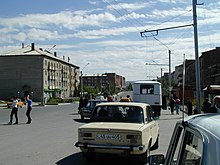
- The economy of Gyumri is mostly depended on construction sector, tourism and banking services. Industry as well has a big share in the domestic product. The most important industrial activities are the production of building materials, yarn and textile manufacturing and food industries. Gyumri is home to Shirak "Gyumri" Beer Company.
- During the pre-Soviet era, Alexandropol was considered to be the third most important trade and cultural center in the Trans-Caucasus after Tiflis and Baku (Yerevan would not rise to prominence until being proclaimed the capital of the independent Republic of Armenia in 1918 and Armenian SSR in 1920). At the end of the 19th century, the population of Alexandropol reached 32,100 residents, mostly Armenians. The first rail link to Alexandropol was finished in 1899, which was the Tiflis-Alexandropol railway. The rail line was then extended from Alexandropol to Yerevan, Jolfa (in 1906), and Tabriz. As a result, Alexandropol became an important rail hub.
Air transportation
Gyumri is served by the Shirak Airport, located about 5 km from the centre of the town. The airport offers regular flights to Moscow, Sochi and Rostov-on-Don. It also serves as an alternate airport to Yerevan's Zvartnots International Airport. Being located on top of high mountains, the Shirak Airport is not of much preferable destinations for most air carriers.
Education
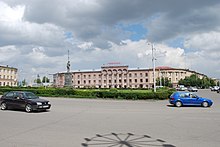
Gyumri has a large number of educational institutions. It is considered the main cultural and educational centre of northern Armenia. The city has three major higher educational centers: the Gyumri State Pedagogical Institute named after Hovhannes Shiraz, "Progress" Gyumri University and "Imastaser Anania Shirakatsi" Gyumri University. Branches of Yerevan State University are also operating in the city. Currently, there are 47 public education schools, 23 nursery schools and 7 special schools for music are operating regularly in the city. Gyumri has a rich heritage of art and cultural legacy, and is considered to be the capital of Armenian humor.
Sport
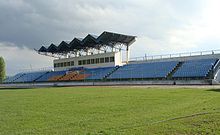
Gyumri has a major contribution in the sports life of Armenia. Many olympic and world champion wrestlers, weightlifters and boxers are from Gyumri. The city is notable for its worldwide champions in individual types of sports, such as Robert Emmiyan in long jump, Yurik Vardanian in weightlifting and Ara Abrahamian in Greco-Roman wrestling. The city is home to the Armenian football (soccer) team FC Shirak. They play their home games at Gyumri City Stadium, built in 1924. Other teams from Gyumri are Aragats and Kumairi. The all-time leading scorer for the Armenia national football team Artur Petrosyan is from Gyumri. Lots of special sport schools are serving the young generation of Gyumri such as the School of Gymnastics, the School of Athletics (named after Robert Emmiyan), the School of football (named after Levon Ishtoyan) and other special schools of boxing, weightlifting, wrestling, martial arts and chess.
Twin cities
 Alexandria, Egypt
Alexandria, Egypt Alexandria, United States
Alexandria, United States Kutaisi, Georgia
Kutaisi, Georgia Kaliningrad, Russia
Kaliningrad, Russia Nardò, Italy
Nardò, Italy Osasco, Brazil
Osasco, Brazil Plovdiv, Bulgaria
Plovdiv, Bulgaria
Demographics
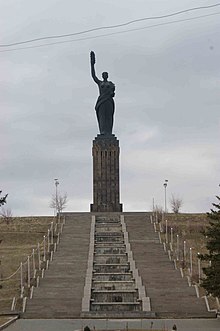
The population of Gyumri has gradually grown since 1840 after gaining the status of town. The huge decline of the population was due to the disastrous earthquake of 1988. The residents here have a distinct look and style, and a boundless pride in their city. Their own dialect is very close to Western Armenian.
Population chart of Gyumri throughout the history:
| Year | Population |
|---|---|
| 1829 | ~600 |
| 1830 | 4,000 |
| 1850 | 15,000 |
| 1873 | 20,000 |
| 1897 | 30,600 |
| 1914 | 51,300 |
| 1923 | 58,600 |
| 1939 | 67,700 |
| 1959 | 108,400 |
| 1970 | 164,966 |
| 1984 | 222,000 |
| 1989 | 122,587 |
| 2001 | 150,917 |
| 2010 | 146,100 |
Famous natives

- Anania Shirakatsi, medieval Armenian scholar
- G.I. Gurdjieff, mystic and philosopher
- Sergey Merkurov, sculptor
- Sheram, gusan, poet and composer
- Avetik Isahakyan, poet
- Armen Tigranian, composer ("Anush" opera)
- Olga Chekhova, actress
- Khachatur Avetisyan, composer
- Shushanik Kurghinian, poet
- Ruben Zaryan, Art historian
- Hovhannes Shiraz, poet
- Mher Mkrtchyan, actor
- Levon Ishtoyan, footballer, Soviet champion with FC Ararat (1973)
- Vazgen Manukyan, politician, Armenia's former Prime Minister
- Svetlana Svetlichnaya, film actress
- Edmond Keosayan, film director
- Artavazd Peleshyan, film director and theorist
- Levon Mkrtchyan, film director
- Yurik Vardanian, weightlifting Olympic champion
- Robert Emmiyan, European long jump record holder
- Artur Petrosyan, footballer, all-time leading scorer for Armenia
- Manvel Gamburyan, mixed martial artist (UFC)
- Ara Abrahamian, wrestler
- Bambir, folk-rock band
- Arthur Sarkissian, artist
- Gennady Timchenko, businessman
- Sergo Chakhoyan, weightlifting world champion
- Ararat Sarkissian, artist
Gallery
-
 Downtown Gyumri
Downtown Gyumri
-
 Educational centre renovated after the earthquake
Educational centre renovated after the earthquake
-
 Gyumri theatre
Gyumri theatre
-
 View from old Gyumri
View from old Gyumri
-
 Snowy Gyumri
Snowy Gyumri
-
 Vardanants Battle memorial
Vardanants Battle memorial
- Mher Mkrtchyan's statue Mher Mkrtchyan's statue
-
 Khachkar in Gyumri
Khachkar in Gyumri
-
 1988 earthquake victims memorial
1988 earthquake victims memorial
-
 Charles Aznavour's statue
Charles Aznavour's statue
Film documentary
- 1983: Hovhannes Shiraz (Հովհաննես Շիրազ / Hovhannes Shiraz / Оганес Шираз Armenfilm 35mm (1915 Genocide Armenian) director Levon Mkrtchyan
- 1987: Gyumri Armenfilm, color, 35mm, Film director Levon Mkrtchyan, narration by Azat Gasparyan
http://www.youtube.com/watch?v=mp07nWWmavM
http://armshop.in.ua/product/hovhannes-shiraz/
See also
References
- Armstats:Population
- ^ Template:Ru icon Leninakan in Great Soviet Encyclopedia
- || GyumriTown.com | The #1 Internet Site for Gyumri Armenia |||
- Hovannisian. Armenia on the Road to Independence, p. 198.
- Vocalno-enciklopedicheskiy slovar, by M. Again (in Russian)
- Georgia Brown (May 2, 2007). Andy Burnham (ed.). "Rebuilding Armenia". The Guardian.
- Armenian Catholic Church:The Eparchy of Armenia & Oriental Europe
- www.gov.am:Religious organizations in Armenia (in Armenian)
- "Virtual Tourist: Gyumri - The capital city of humor of Armenia". Archived from the original on 2010-12-06.
{{cite web}}: Unknown parameter|deadurl=ignored (|url-status=suggested) (help) - Municipality of Gyumri:Population
- Gyumri at GEOnet Names Server
- Report of the results of the 2001 Armenian Census, Statistical Committee of Armenia
- World Gazeteer: Armenia – World-Gazetteer.com
Footnotes
- See: Encyclopedia Britannica
- Adrian Room, Placenames of the World: Origins and Meanings of the Names for Over 5000 Natural Features, Countries, Capitals, Territories, Cities and Historical Sites, McFarland, 1997, ISBN 978-0-7864-1814-5 (pbk) p. 192
- See http://www.gyumri.am/eng/history.html
External links
- Official municipality website
- City website Template:En icon
- Gyumri Video
- Shirak
- Flash Gallery of 2005 Gyumri
- Surp Amenaprkich cathedral in Gyumri
| Capital: Gyumri | ||
| Urban settlements |  | |
| Akhuryan Municipality | ||
| Amasia Municipality | ||
| Ani Municipality | ||
| Artik Municipality | ||
| Ashotsk Municipality | ||